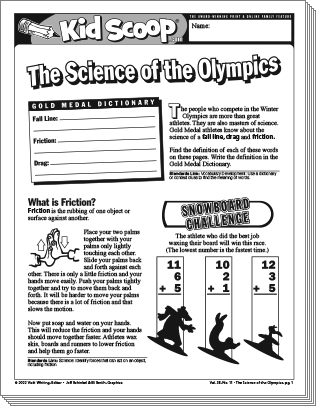 Professional athletes are not only highly skilled at their favorite sport, they’re also scientists who understand how physical forces help them win! The Winter Olympics are a perfect time to learn how fractions of a second shaved off the clock make the difference between winning—or losing—a medal. Understanding how forces like friction, drag, and fall line impact Olympic results makes learning physics fun! Ride along with three animal competitors as they bobsled, downhill ski, and snowboard to the finish line! Calculate multiple sums to discover fastest times and medal winners. Then grab a pencil, close your eyes, and try your hand at a slalom run on paper. Whee! You’re off!
Professional athletes are not only highly skilled at their favorite sport, they’re also scientists who understand how physical forces help them win! The Winter Olympics are a perfect time to learn how fractions of a second shaved off the clock make the difference between winning—or losing—a medal. Understanding how forces like friction, drag, and fall line impact Olympic results makes learning physics fun! Ride along with three animal competitors as they bobsled, downhill ski, and snowboard to the finish line! Calculate multiple sums to discover fastest times and medal winners. Then grab a pencil, close your eyes, and try your hand at a slalom run on paper. Whee! You’re off!
In this issue students will:
- read informational text about the physics involved with sports
- understand the meaning of fall line, drag, and friction and their impact on speed
- calculate multiple digit sums
- conduct simple experiments
- create a poster representing the Olympic spirit with pictures and words found in the news
- identify medal winners
- use the newspaper to locate practices that respect the environment
- write about your favorite national hero
7 page PDF
